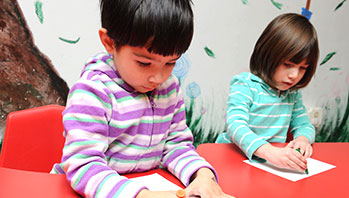- markers or crayons
- white construction paper
- whole watermelon and cubes of watermelon (seedless)
- fruit
- seed
MA Standards:
Writing/W.PK.MA.2: Use a combination of dictating and drawing to explain information about a topic.
Head Start Outcomes:
Literacy Knowledge/Early Writing: Uses scribbles, shapes, pictures, and letters to represent objects, stories, experiences, or ideas.
PreK Learning Guidelines:
English Language Arts/Composition 16: Use their own words or illustrations to describe their experiences, tell imaginative stories, or communicate information about a topic of interest.
Draw and Write Together: Watermelon

© Commonwealth of Massachusetts, Department of Early Education and Care (Jennifer Waddell photographer). All rights reserved.
STEM Key Concepts: Many of the foods that animals, including humans, eat come from plants; We eat certain leaves, roots, fruits, and seeds
ELA Focus Skills: Concepts of Print (Print Carries Meaning), Listening and Speaking, Vocabulary
Educator Prep: Prepare for each child a sheet of paper with a title line and an author line.
Safety Tips:
- Remind children to wash their hands before and after the activity.
- Take children’s dietary needs into account before introducing them to any food items.
Tell children they are going to write about a slice of watermelon. Explain that you are going to give each child a few cubes of watermelon to eat. Say, You can eat these pieces of watermelon to help you remember the watermelon slice you ate as you were estimating.
Have each child draw the watermelon. Then have each child dictate or write two ideas about the watermelon. Prompt with questions such as,
- What was the texture of the watermelon skin?
- What color is the watermelon?
- What did it taste like when you bit into it?
- What did it smell like? What was its aroma?
Once children have finished their page, have them write their name and then make a group book. Have each child “read” their part of the “Watermelon” story and then leave it in the Library Center for children to revisit.
Social Emotional Tip: Having children express their preferences develops and builds their ability to recognize and express their own thoughts, ideas, and opinions.
